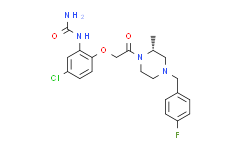| Description: |
BX471 (ZK-811752) is a potent and selective non-peptide CCR1 antagonist with a Ki of 1 nM, and exhibits 250-fold selectivity for CCR1 over CCR2, CCR5 and CXCR4. |
| In Vivo: |
BX471 (4 mg/kg, p.o. or i.v.) is orally active with a bioavailability of 60% in dogs. Furthermore, BX471 effectively reduces disease in a rat experimental allergic encephalomyelitis model of multiple sclerosis[1]. BX471 (20 mg/kg, s.c.) reaches peak plasma levels of 9 μM by around 30 minutes, and this rapidly declines to approximately 0.4 μM after 2 hours. From 4 to 8 hours the drug plasma levels drops to 0.1 μM or lower. Mice treated with 20 mg/kg of BX471 for 10 days shows a reduction of interstitial CD45 positive leukocytes of approximately 55%. BX471 has a borderline significant effect on the number of CCR5-positive CD8 cells in the peripheral blood. BX471 reduces the amount of FSP1-positive cells by 65% in UUO kidneys as compared with vehicle control[2]. Pretreatment witih BX471 reduces macrophage and neutrophil accumulation in kidney after ischemia-reperfusion injury[3]. |
| In Vitro: |
BX471 is a potent functional antagonist based on its ability to inhibit a number of CCR1-mediated effects including Ca2+ mobilization, increase in extracellular acidification rate, CD11b expression, and leukocyte migration. BX471 demonstrats a greater than 10,000-fold selectivity for CCR1 compared with 28 G-protein-coupled receptors[1]. BX471 is also able to displace 125I-MIP-1α/CCL3 binding to mouse CCR1 in a concentration-dependent manner with a Ki of 215±46 nM. Increasing concentrations of BX471 inhibits the Ca2+ transients induced by MIP-1α/CCL3 in both human and mouse CCR1 with IC50 of 5.8±1 nM and 198±7 nM, respectively[2]. BX471 (0.1-10 μM) shows a dose-dependent inhibition of RANTES-mediated and shear-resistant adhesion on IL-1β-activated microvascular endothelium in shear flow in isolated blood monocytes. BX471 also inhibits the RANTES-mediated adhesion of T lymphocytes to activated endothelium[4]. |






















